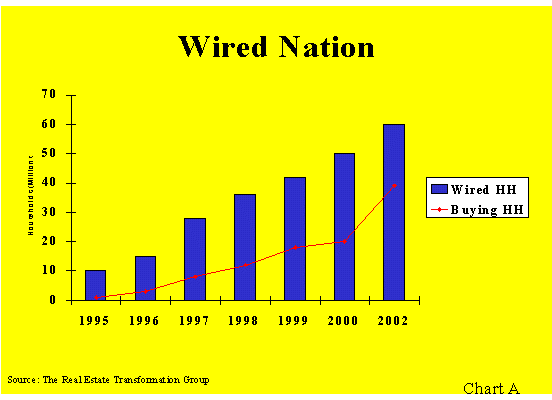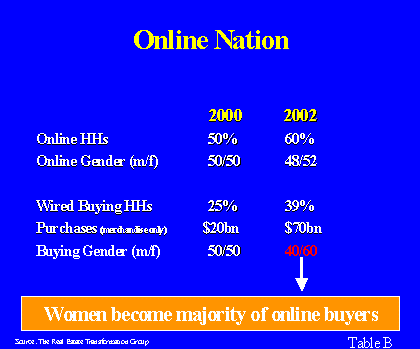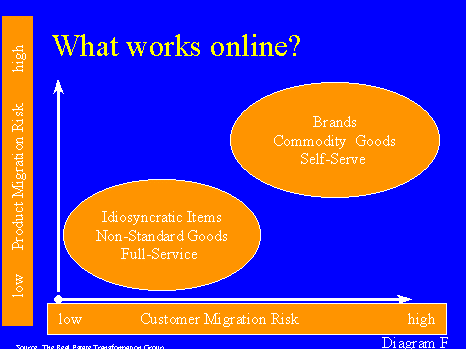Online Buying Defies Site Selection Folklore* June 2000 Mark Borsuk** Managing Director The growth of online buying undermines the key assumptions in site selection analysis used by mass merchandisers. The rise of the non-geocentric buying habit presents new risks for property investors and lenders. Furthermore, current techniques fail to anticipate the impact of online buying, giving developers and retailers potentially false signals on new store profitability. The pervasive belief wired customers will continue to shop in the same old way is an idea ready for the dustbin of history. In response to the growth of the non-geocentric buying habit, mass retailers must use additional metrics to decide on the need for new stores, the appropriate number of locations within an existing trade area and store size. Using the INFOTECH SCAN to test store profitability from potential online cannibalization is a promising technique. 1. What is the problem with site selection analysis? The customer’s geographic proximity to the proposed location is the fundamental basis for site analysis. Historically, a retailer’s profitability depended on expanding sales created by new store openings. Methods arose to select sites with the highest sales potential. The site with the highest sales potential is most often a function of the number of likely customers within a defined geographic area and the travel time to the proposed location. The rent rate is bounded by the site’s sale potential. In turn, a property’s value is based on the amount of rent paid by the merchant. Online buying threatens store sales, potentially reducing store profits and the ability to sustain current rents. Unless site selectors begin to incorporate the sales cannibalization threat from cyberspace into their methodology, they risk choosing poor locations. However, as recognition spreads about the phenomenon, project developers and landlords may face intense pressure over existing rent levels from merchants. II. Why is there a problem with site selection analysis? Inertia, cognitive dissonance and a recognition lag are responsible for the problem. There remains great reluctance among the site analysis community to recognize the methodology’s inherent weakness in a wired world.[1] In addition, the traditional providers of demographic and psychographic data are not for the most part incorporating technographics[2] into their analysis. Furthermore, by not recognizing online buying’s irresistible value proposition for customers, retailers, property developers and landlords are not demanding a radical revision to the geocentric site selection model so as to better account for the new shopping habit. Finally, there has been a belief, albeit unarticulated, women would not embrace information technology and by extension shop online. This further undermines the implicit assumptions associated with present site selection methodology. Wall Street is also beginning to connect the dots between the growth of online buying, store location and store size. In February, Bear Stearns released a massive study on the Internet’s economic impact entitled “e-volve: Dot-Com and Beyond.” In the section called “The Empire Strikes Back”, the specialty retail and broadlines analysts said “We believe that the Internet can also radically change how traditional retailers operate, locate stores, size stores, inventory stores, etc.” [emphasis added] They noted department stores like Macy’s could open smaller units “…and rely on e-commerce to fill in the assortment gaps.” They also foresaw specialty stores operating with smaller stores but in more locations. The report presages the reformation of the sales channel matrix necessitated by the Internet. Wall Street’s new focus on store count and size will spur a reappraisal of store location analysis. Pressure is building to bring traditional site selection analysis into sync with the wired world. It is time to move away from the C.R.A.P. fixation, recognize the importance of the online nation and the irresistible value proposition cybershopping presents to customers. Furthermore, analysts must be cognizant of the expanding pie myth. Finally, the wired world demands practitioners pay attention to the interaction among technographics, Pareto’s rule and marginal sales analysis so they may better forecast a location’s sales potential. C.R.A.P Fixation. The retailing growth model fixates on the Consumption Related Analysis of Place. The site search begins with seeking to locate the greatest number of target customers within an area. The demographics of age, education, gender, household income, population density, race and ethnicity along with psychographics help to pinpoint desirable locations. Examining historical sales data by merchandise category, general characteristics of the trade area, proximity to competitors, traffic flows, drive times and anchor tenants refine the selection process. However, this winnowing process breaks down when customers make their purchases online. In addition, the model’s need for the automobile to be a human prosthesis and immutable belief in the geocentric buying habit conspire to fatally compromise its usefulness in a wired world. America is rapidly becoming a wired nation. Site selection analysis can no longer ignore the fundamental change in buying habits induced by the Internet. Demographic and psychographic data does not tell the full story. Site selection methodology must incorporate survey information about online households, buying propensities and the attributes of the wired lifestyle to better capture this trend for purposes of site selection. Today, there are number of firms offering this information. Companies like Forrester Research, the proponent of technographics [ www.forrester.com ], Scarborough Research [ www.scarborough.com ], NFO interactive[ www.nfoi.com ], Jupiter Research [ www.jup.com ] and Cyberdialogue [ www.cyberdialogue.com ] can provide the necessary information for reconfiguring the methodology to incorporate the sales migration potential into the site selection analysis. Those attending this year’s ICSC Convention in Las Vegas should visit the trade show to see how the traditional demographic database providers are pursuing the challenge and what new firms seek to fill the gap. Online Nation. A growing portion of America is moving online to purchase, and almost forty million households will be buying online in 2002. See Chart A. More importantly, women are at parity with men as online buyers although they still lag in total dollars spent. In two years expect them to become the majority of purchasers. See Table B. Wal-Mart’s effort to expand online will also swell the ranks of potential buyers. Discount Store News reported forty percent of the markets where Wal-Mart operates lack a local Internet dial-up connection. Their alliance with AOL will provide the connection.[3]
Irresistible Value Proposition Cannibalizes In-Store Sales. What is driving people to buy online? The Internet matches the best attributes of the Category Killer’s emphasis on wide selection, everyday low price and convenience. In the physical world there is a trade-off between convenience and low price. See Diagram C. In cyberspace there is little trade-off. The customer receives low price with minimal effort when immediate gratification is unnecessary. In most instances, this holds true even when shipping costs and any taxes are included. What online buying does is take the drudgery out of everyday restocking, purchasing name brands and ordering pre-selected items. This is a very attractive feature for women. In sum, a new buying habit not tied to place is emerging.
A more ominous aspect of online buying is its new role as price arbiter. The lowest national price on many products is now only a few clicks away on the Internet. As a result, Web sites like www.evenbetter.com , www.mySimon.com and other shopbots create a hostile environment for location-based merchants primarily competing on price and selection. Traditional merchants with transactional Web sites face a margin death spiral over pricing. Should the in-store price match the online price? Should the online price seek to match a competitor’s lower online price? Will store customers migrate to the retailer’s site to capture a better price? The net result erodes margins. Marginal Sales Analysis. Marginal sales analysis is the connection between online sales cannibalization and store profitability. The high fixed cost of operating a store makes it vulnerable to small changes in sales. Thus, the online sales channel need only induce a small shift in buying to exert a deleterious effect on profitability. Research conducted by PriceWaterhouseCoopers shows a mere five percent decline in sales pushed net income down twenty percent [4] A study presented at the 1997 ICSC Research Conference by a national retailer demonstrated that a seven percent fall in sales drove profits down by fifty percent! See Chart D. Analysis done by the Boston Consulting Group also confirms small shifts have big impacts on retailer profits.[5] Thus, site selection must take into account how quickly store performance can deteriorate because of the online hungry cannibal.
Expanding Pie Myth. Many believe there will be little if any impact from online sales cannibalization. The underlying assumption is that continued sales growth attenuates the impact. The expanding pie myth has several versions. One version presupposes buyers continue to frequent the store after some initial sales loss. Thereafter, an asymptotic state is quickly reached and online sales as a percentage of total sales do not increase. The myth assumes customers do not change their geocentric buying habits over time. This is a rather dubious assumption given online buying’s growing popularity. Chart E depicts a more likely scenario. The Chart shows a rising percentage of transactions done online over time. In this scenario, in-store sales are cannibalized or future sales growth retarded. A second version of the expanding pie myth is the accretive versus dilutive argument. Here the emphasis is on specific categories like books. The accretive argument maintains the Internet stimulates demand so both store and online sales increase, leading to little cannibalization. Assuming additional demand could be stimulated, why does it follow store sales would necessarily benefit? Depending on the merchandise category, it is equally plausible that demand can increase but primarily benefit the online channel. Readers can examine their own book purchasing habits to test the hypothesis. Are they purchasing more books than before? If so, are they steadily increasing the number of books purchased online at the expense of the store? Is online buying beginning to cannibalize store sales or retard their growth? The last quarter of 1999 offers some tantalizing clues. CompUSA and Toys-R-Us found year-over-year store sales actually declined in an otherwise robust fourth quarter. Traditional competitors, online competitors or a combination of the two could account for their dismal performance. However, it may be the ferocious competition from pure-plays and traditional competitors’ Web sites that was the grinch that stole Christmas. Technographics. Like demographics and psychographics, technographics seeks to understand an individual’s attitude towards using technology and specifically the Internet. If the retailer’s most profitable customers are “technology optimists,” then they have a high propensity to search, browse and buy online. As Mary Modal states in her book “…demographic factors such as age, race, and gender don’t matter anywhere near as much as the consumers’ attitudes towards technology.”[6] [emphasis in the original] Overlying Pareto’s Rule. Applying Pareto’s rule to the mass merchandiser’s customer base is another important link between online sales cannibalization and store profitability. The rule postulates eighty percent of profits are derived from twenty percent of customers. If this observation holds for the retailer, what happens when the small group of customers, responsible for most of the profits, migrate their transactions online? The result is a nightmare scenario whereby stores are kept open for eighty percent of the customers generating twenty percent of the profits. Analysts must determine how well Pareto’s Rule fits the customer profitability profile. Is there a small group accounting for most of the profits? For example, food retailers find twenty percent of their customers generate about eighty percent of the gross profits and twenty percent of the fast-food patrons make sixty percent of the visits.[7] Does the rule, when applied to the customers, vary by state, region or store? If so, what are the technographics of the group? In the future, the site selectors' due diligence obligations will compel them to conduct a customer technographic analysis, determine whether profitable customers conform to Pareto's Rule and examine how sales cannibalization can impact store performance. By doing so, they will add a margin of safety to the location decision. II.
What is the solution to the site selection problem? Question 1. Does the merchandise work online? The universe of goods and services is comprised of those that work online, those that may work online and those unlikely to work online. See Diagram F. What are the characteristics of goods easily purchased online? They are products where the merchant adds little or no value to the transaction (self-service), are commodity-like and recognized brands. Examples include computers, toys, books, consumer electronics, office and pet supplies, typical grocery and personal care items and prescription drugs. Conversely, if the retailer adds value, the items are irregular or an aesthetic judgment is necessary, the merchandise fares poorly in cyberspace. The fabric store is an example.
Question 2. Is the target customer a technology optimist or pessimist? The critical inquiry is about the retailer’s target customer. What is her technographic profile? Is she a technological optimist or pessimist? Does she cluster in areas with a high online population? Is she time-starved? Is she already buying online? If not, when is she likely to begin? The greater the technological optimism expressed by the merchant’s target customer, the higher the likelihood that the traditional location selection process will overestimate the value of place. Question 3. Does Pareto’s rule apply to the target customer? The best situation for a location-based retailer is to discover that the twenty percent of the customer base generating eighty percent of the profits are technological pessimists. This does not mean they are all low income individuals but rather they are just not interested. Mary Modal of Forrester Research estimates pessimists account for forty-eight percent of the adult population or ninety-eight million individuals.[8] However, it is more likely the majority of retailers and developers focus on the one hundred and six million technological optimists. This is where the analysis is crucial. It is too easy to think, “what is, ought to be” and dismiss the possibility of women embracing the wired lifestyle. The advantages of going online to save time, comparison shop and buy many restocking items and typical brand name items is too great to ignore. Reject the Folklore. Traditional site selection methodology is in need of an overhaul. It is time to recognize the inherent limitation of geocentric analysis. The projected growth in online buying households to forty percent is going to impact store performance. The marginal sales analysis demonstrates the high risk to merchants. Even a small shift of in-store sales to cyberspace can dramatically impact store profitability. The retailers who recognize the importance of the non-geocentric buying habit are the ones most likely to integrate the online sales channel with a store network that works best for customers. Site selectors must fashion new tools to build that network and discard the folklore. (Revised June 11, 2000, submitted March 29, 2000) *Shopping Center Business, May 2000, pp. 300-306 **Mark Borsuk (mark@borsuk.com), a retail leasing broker and property attorney practicing in San Francisco, is managing director of The Real Estate Transformation Group. The firm analyzes information technology’s impact on retail space demand and provides strategies for property developers, investors, merchants and lenders. Registration pending for INFOTECH SCAN service mark. (Biography) (List of articles by Mark Borsuk) ***Copyright © 2000. Mark Borsuk. All Rights Reserved, except the reader may copy this article into electronic form or print for personal use only, provided that: 1) the article is not modified; and 2) all such copies include this copyright notice.
[2] Mary Modahl, Now or Never, HarperBusiness, New York, 2000. [3]Mike Troy, Wal-Mart, AOL form alliance of giants, Discount Store News, January 3, 2000, pp. 1, 48. [4] Karl Haller, Consumers Fuel Online Retail Explosion, The State of Retail Technology 1999, Supplement to RT Magazine, May 1999, pp. 39-40. [5] Philip Evans and Thomas S. Wurster, Blown to Bits, Harvard Business School Press, 2000, pp. 96, 116. [6] Mary Modal, Now or Never, p. xx. [7] Brian P. Woolf, Customer Specific Marketing, Teal Books, Greenville, SC, 1996, pp. 11-14; Garth Hallberg, All Consumers Are Not Created Equal, John Wiley & Sons, New York, 1995, pp. 27, 233; Jennifer Ordonez, Hamburger Joints Call Them ‘Heavy Users’-But Not to Their Faces, Wall Street Journal, Wednesday, January 12, 2000, pp. A1, A10. [8] Mary Modal, Now or Never, pp. xxii-xxiii. Real Estate Transformation Group Articles by Mark Borsuk News Releases | Articles | Upcoming Talks | Memorable Quotes Copyright ©1995 - 2020. Mark Borsuk. All rights reserved. Disclaimer notice |






